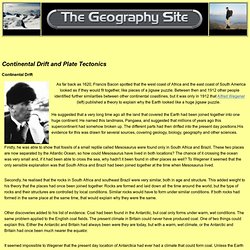

The deepest place on the earth. The Mariana Trench! BBC Earth - Mid-ocean ridges create new sections of tectonic plates. Seafloor Spreading. Fault Motion Animations : IRIS. Pangaea - ZoomSchool. Advertisement.

EnchantedLearning.com is a user-supported site. As a bonus, site members have access to a banner-ad-free version of the site, with print-friendly pages.Click here to learn more. (Already a member? Click here.) Pangaea The Earth's rocky outer crust solidified billions of years ago, soon after the Earth formed. The plates are made of rock and drift all over the globe; they move both horizontally (sideways) and vertically (up and down).
The map of the Earth is always changing; not only are the underlying plates moving, but the plates change in size. PLATE TECTONICS The theory of plate tectonics (meaning "plate structure") was developed in the 1960's. The plates are moving at a speed that has been estimated at 1 to 10 cm per year. The top layer of the Earth's surface is called the crust (it lies on top of the plates). ACTIVITIES ABOUT EARTH'S CONTINENTAL PLATES An interactive quiz about plate tectonics A quiz about Continental drift and plate tectonics from ZoomSchool.com E-mail. Plate tectonics. Geography Site: Plate Tectonics. Continental Drift and Plate Tectonics Continental Drift As far back as 1620, Francis Bacon spotted that the west coast of Africa and the east coast of South America looked as if they would fit together, like pieces of a jigsaw puzzle.

Between then and 1912 other people identified further similarities between other continental coastlines, but it was only in 1912 that Alfred Wegener (left) published a theory to explain why the Earth looked like a huge jigsaw puzzle. He suggested that a very long time ago all the land that covered the Earth had been joined together into one huge continent. He named this landmass, Pangaea, and suggested that millions of years ago this supercontinent had somehow broken up. Firstly, he was able to show that fossils of a small reptile called Mesosaurus were found only in South Africa and Brazil. Secondly, he realised that the rocks in South Africa and southeast Brazil were very similar, both in age and structure.
Other discoveries added to his list of evidence. Speed of the Continental Plates. Topic index | author index | special index Plate tectonics is a relatively new theory in the field of geology.

It states that the lithosphere of the earth is divided into a small number of plates which float on and travel independently over the athenosphere, which lies over the mantle. Much of the earth's seismic activities occurs at the boundaries of these plates. It is a relatively slow movement, driven by thermal convection currents and other geological activity originating deep within the earth's mantle.
This theory of plate tectonics replaced the previous one of continental drift, where it was thought that just the continents themselves drifted over the earth's surface. Most of my research turned up theories and not hard experimental data and those measurements that I was able to obtain were averages or estimations. However, the velocities, in some sources, of the plates are measured as absolute and/or relative motion. Zhen Shao Huang -- 1997 Editor's Supplement -- 2001.
Compositional and Mechanical Layers of the Earth. Earthguide Online Classroom - Maps related to plate tectonics.